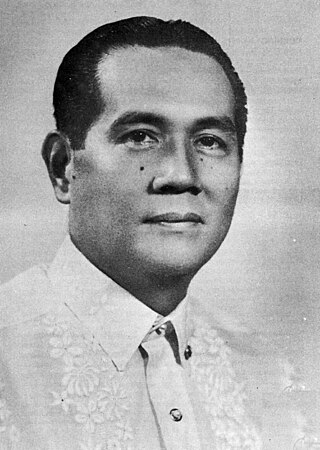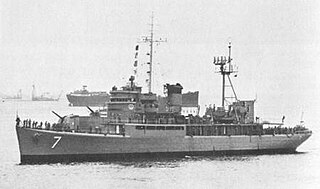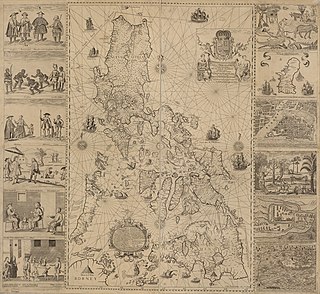
Edward Geary Lansdale was a United States Air Force officer until retiring in 1963 as a major general before continuing his work with the Central Intelligence Agency (CIA). Lansdale was a pioneer in clandestine operations and psychological warfare. In the early 1950s, Lansdale played a significant role in suppressing the Hukbalahap rebellion in the Philippines. In 1954, he moved to Saigon and started the Saigon Military Mission, a covert intelligence operation which was created to sow dissension in North Vietnam. Lansdale believed the United States could win guerrilla wars by studying the enemy's psychology, an approach that won the approval of the presidential administrations of both John F. Kennedy and Lyndon B. Johnson.

Diosdado Pangan Macapagal Sr. was a Filipino lawyer, poet and politician who served as the ninth President of the Philippines, serving from 1961 to 1965, and the sixth Vice President, serving from 1957 to 1961. He also served as a member of the House of Representatives, and headed the Constitutional Convention of 1970. He was the father of Gloria Macapagal Arroyo, who followed his path as President of the Philippines from 2001 to 2010.

Southwest Cay, also known as Vietnamese: Đảo Song Tử Tây; Pugad Island ; Mandarin Chinese: 南子島/南子岛; pinyin: Nánzi Dǎo, is an island on the northwestern edge of the Spratly Islands in the South China Sea. It is part of the atoll North Danger Reef, and just 1.75 miles (2.82 km) southwest of Northeast Cay. With an area of 12 hectares, it is the sixth largest of the naturally occurring Spratly Islands, and the second largest of the Vietnamese-occupied islands. Southwest Cay has the archipelago's highest point, at 4 meters above sea level. It was once a breeding place for birds, and was covered with trees and guano; export of guano had been carried out "on a considerable scale".

USCGC Dallas (WHEC-716) was a United States Coast Guard high endurance cutter commissioned in 1967 at the Avondale Shipyard in New Orleans, Louisiana. She was the sixth ship or boat to bear the name of Alexander J. Dallas, the Secretary of the Treasury under President James Madison (1814–1816). She is one of twelve Hamilton-class cutters built for the Coast Guard.

The USCGC Morgenthau (WHEC-722), was the eighth of twelve 378-foot dual-powered turbine/diesel Hamilton-class high endurance cutters (WHECs) built by Avondale Shipyards in New Orleans, Louisiana. The Coast Guard commissioned the Morgenthau on March 10, 1969. After 48 years of continuous service the U.S. Coast Guard decommissioned the Morgenthau on April 18, 2017, and the ship was sold to Vietnam. On 27 May 2017 the Vietnam Coast Guard commissioned the former cutter as patrol ship CSB 8020.

This article covers the history of the Philippines from the recognition of independence in 1946 to the end of the presidency of Diosdado Macapagal that covered much of the Third Republic of the Philippines, which ended on January 17, 1973, with the ratification of the 1973 Constitution of the Republic of the Philippines.

USS Bering Strait (AVP-34) was a United States Navy Barnegat-class small seaplane tender in commission from 1944 to 1946. She tended seaplanes during World War II in the Pacific in combat areas and earned three battle stars by war's end.

USS Cook Inlet (AVP-36) was a United States Navy Barnegat-class small seaplane tender in commission from 1944 to 1946. She tended seaplanes during World War II in the Pacific and earned one battle star for her service. After the war, she was transferred to the United States Coast Guard, and was in commission as the Coast Guard cutter USCGC Cook Inlet (WAVP-384), later WHEC-384, from 1949 to 1971. She saw service in the Vietnam War during her Coast Guard career, receiving two campaign stars for her operations during the conflict. Transferred to South Vietnam in 1971, she operated as the Republic of Vietnam Navy frigate RVNS Trần Quốc Toản (HQ-06) until South Vietnam's collapse in April 1975 at the end of the Vietnam War. She fled to the Philippines and in 1976 was transferred to the Philippine Navy, which never commissioned her, instead using her as a source of spare parts for her sister ships, the Andrés Bonifacio-class frigates, before discarding her in 1982.

BRP Andrés Bonifacio (PF-7) was a Philippine Navy frigate in commission from 1976 to 1985. She was one of six ex-United States Navy Barnegat-class small seaplane tenders/ex-United States Coast Guard Casco-class high endurance cutters received from the United States after the Vietnam War, two of which were acquired to supply spare parts for the other four. Andrés Bonifacio was considered the lead ship of her class in the Philippine Navy, and she and her three commissioned sister ships were the largest Philippine Navy combat ships of their time.

USS Chincoteague (AVP-24) was a United States Navy seaplane tender in commission from 1943 to 1946 that saw service in the Pacific during World War II. After the war, she was in commission in the United States Coast Guard as the cutter USCGC Chincoteague (WAVP-375), later WHEC-375, from 1949 to 1972. She was transferred to South Vietnam in 1972 and was commissioned into service with the Republic of Vietnam Navy as the frigate RVNS Lý Thường Kiệt (HQ-16), seeing combat in the Battle of the Paracel Islands in 1974. When South Vietnam collapsed at the conclusion of the Vietnam War in 1975, she fled to the Philippines, where she was commissioned into the Philippine Navy, serving as the frigate RPSAndrés Bonifacio (PF-7) from 1976 to 1985.
The BRP Francisco Dagohoy (PF-10) was an Andrés Bonifacio-class frigate of the Philippine Navy that served from 1979 to 1985. She was one of six ex-United States Navy Barnegat-class small seaplane tenders and ex-United States Coast Guard Casco-class high endurance cutters received from the United States after the Vietnam War, two of which were cannibalized for spare parts without entering service. She and her other three sister ships were the largest Philippine Navy ships of their time.
The BRP Gregorio del Pilar (PF-8) was an Andrés Bonifacio-class frigate of the Philippine Navy in commission from 1977 to 1990. She was one of six ex-United States Navy Barnegat-class seaplane tenders/ex-United States Coast Guard Casco-class high endurance cutters received from the United States after the Vietnam War, two of which were acquired to supply spare parts for the other four. She and her three commissioned sister ships were the largest Philippine Navy combat ships of their time.

USS Castle Rock (AVP-35) was a United States Navy Barnegat-class small seaplane tender in commission from 1944 to 1946 which saw service in the late months of World War II. After the war, she was in commission in the United States Coast Guard as the Coast Guard cutter USCGC Castle Rock (WAVP-383), later WHEC-383, from 1948 to 1971, seeing service in the Vietnam War during her Coast Guard career. Transferred to South Vietnam in 1971, she served in the Republic of Vietnam Navy as the frigate RVNS Trần Bình Trọng (HQ-05) and fought in the Battle of the Paracel Islands in 1974. When South Vietnam collapsed at the end of the Vietnam War in 1975, Trần Bình Trọng fled to the Philippines, where she served in the Philippine Navy from 1979 to 1985 as the frigate RPSFrancisco Dagohoy (PF-10).

USS Wachapreague (AGP-8) was a motor torpedo boat tender in commission in the United States Navy from 1944 to 1946, seeing service in the latter part of World War II. After her Navy decommissioning, she was in commission in the United States Coast Guard from 1946 to 1972 as the cutter USCGC McCulloch (WAVP-386), later WHEC-386, the fourth ship of the U.S. Coast Guard or its predecessor, the United States Revenue Cutter Service, to bear the name. In 1972 she was transferred to South Vietnam and served in the Republic of Vietnam Navy as the frigate RVNS Ngô Quyền (HQ-17). Upon the collapse of South Vietnam at the end of the Vietnam War in 1975, she fled to the Philippines, and she served in the Philippine Navy from 1977 to 1985 as the frigate RPSGregorio del Pilar (PF-8) and from 1987 to 1990 as BRP Gregorio del Pilar (PF-12).

The Barnegat class was a large class of United States Navy small seaplane tenders (AVP) built during World War II. Thirty were completed as seaplane tenders, four as motor torpedo boat tenders, and one as a catapult training ship.

The Philippines–Vietnam relations refers to the bilateral relations of the Republic of the Philippines and the Socialist Republic of Vietnam. Since the end of the Cold War, relations between the two countries have warmed significantly. Vietnam is sometimes referred to as the only communist military ally of the Philippines, especially after Vietnam joined ASEAN in 1995. Both nations have cooperated in the fields of education, tourism, agriculture, aquaculture, trade, and defense. Additionally, both nations have similar positions on the South China Sea issue, with Vietnam backing the Philippine victory in the ICC against China, and the Philippines backing to a certain extent the claim of Vietnam in the Paracels. Both nations have overlapping claims in the Spratlys, but have never made military confrontations as both view each other as diplomatic allies and ASEAN brethren.

The history of the Philippine Army began in during pre-colonial era as different tribes established their own citizen force to defend the Balangays from intruders. Army was organized forces through the years who fought Spanish oppression and even other invaders such as Dutch and British who attempted to conquer the Philippines in early centuries.
The Philippine Civic Action Group – Vietnam (PHILCAG–V) was the Armed Forces of the Philippines contingent sent to the Republic of Vietnam or South Vietnam during the Vietnam War. This was an answer by the Philippine government to the request made by South Vietnam and the United States for combat troops. While combat troops were sent, the main mission given to PHILCAG was in the area of pacification, civic engagement, engineering, and medical missions. At its peak, the PHILCAG-V had more than 182 officers and 1,882 enlisted personnel cantoned at the Tay Ninh Combat Base. In the course of 8 years, the Philippines sent about 10,450 personnel during the Vietnam. 9 members of the contingent have died, and more than 64 have been wounded.





















